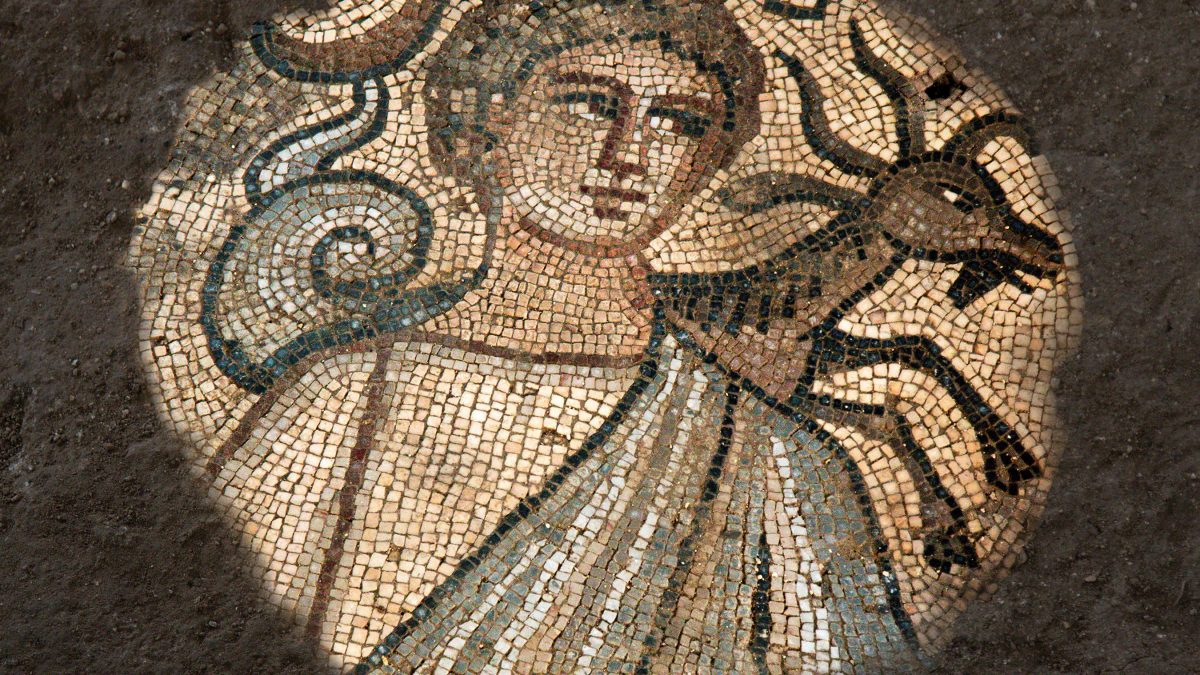An ancient Galilean synagogue continues to yield stunning mosaics
A team of specialists and students led by Carolina professor Jodi Magness has uncovered additional mosaic scenes in the Late Roman synagogue at Huqoq, an ancient Jewish village.

A team of specialists and students led by University of North Carolina at Chapel Hill professor Jodi Magness has uncovered additional mosaic scenes in the Late Roman synagogue at Huqoq, an ancient Jewish village in Israel’s Lower Galilee. The new finds provide insight about daily life in the fifth century C.E. and expand the rich repertoire of mosaics already discovered decorating the floors of the building.
Magness, the Kenan Distinguished Professor of religious studies in Carolina’s College of Arts & Sciences, along with Assistant Director Shua Kisilevitz of the Israel Antiquities Authority, focused this seventh season of Huqoq excavations on the southern part of the nave (main hall), where three panels were exposed.
A medallion in the center of the uppermost (northern) panel depicts the Greco-Roman sun god Helios in a quadriga (four-horse chariot) surrounded by personifications of the months and the signs of the zodiac, contained within a square frame with personifications of the four seasons in the corners.
The second panel shows the biblical story of Jonah and the whale with a twist: Jonah’s legs are shown dangling from the mouth of a large fish, which is being swallowed by a larger fish, and the larger fish is being swallowed by an even larger fish. This is the first time the story of Jonah has been discovered decorating the mosaic floor of an ancient synagogue in Israel.
The third (southernmost) panel contains a detailed scene of men at work constructing a stone tower, apparently the Tower of Babel.
“The Huqoq mosaics are unusually rich and diverse,” said Magness. “In addition, they display variations on biblical stories which must represent oral traditions (midrashim) that circulated among the local Jewish population.”
Mosaics were first discovered at the site in 2012, and work has continued each summer since then. In 2012, a mosaic depicting Samson and the foxes (as related in the Bible’s Judges 15:4) was found in the synagogue’s east aisle. The next summer, an adjacent mosaic was uncovered that shows Samson carrying the gate of Gaza on his shoulders (Judges 16:3). Another mosaic discovered in the synagogue’s east aisle in 2013 and 2014 depicts the first non-biblical story ever found decorating an ancient synagogue — perhaps the legendary meeting between Alexander the Great and the Jewish high priest.
A mosaic panel uncovered in 2015 next to this scene contains a Hebrew inscription surrounded by human figures, animals and mythological creatures including putti (cupids). Mosaics discovered in the northern part of the nave (main hall) in 2016 portray two biblical stories: Noah’s Ark and the parting of the Red Sea, in which Pharaoh’s soldiers are swallowed by large fish similar to the fish swallowing Jonah in the mosaic uncovered this summer.
“One of the distinguishing features of the Huqoq mosaics is the incorporation of numerous classical (Greco-Roman) elements such as putti, winged personifications of the seasons, and — in the Jonah scene — harpies (large birds with female heads and torsos representing storm winds),” said Magness. “The mosaics also provide a great deal of information about ancient daily life, such as the construction techniques shown in the Tower of Babel scene uncovered this summer.”
Sponsors of the project are UNC-Chapel Hill, Baylor University, Brigham Young University and the University of Toronto. Students and staff from Carolina and the consortium schools participated in the dig. Financial support for the 2017 season was also provided by the National Geographic Society, the Loeb Classical Library Foundation, the International Catacomb Society and the Carolina Center for Jewish Studies at UNC-Chapel Hill.
The mosaics have been removed from the site for conservation, and the excavated areas have been backfilled. Excavations are scheduled to continue in summer 2018. For additional information and updates, visit the project’s website: www.huqoq.org.




